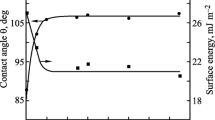Abstract
Amines, in general, and 3-aminopropyltriethoxysilane, in particular, were shown to improve the adhesion of a polyurethane to glass. At equivalent concentrations of amine in the solutions used to treat the glass the order of increase in the work of adhesion was 3-aminopropyltriethoxysilane » 1, 4-diaminobutane ≃ p-phenylenediamine > piperazine » aniline. The polyurethane was prepared from ARCO’s hydroxy — terminated polybutadiene, R-45HT, toluene diisocyanate, trimethylolpropane and N,N-bis (2-hydroxypropyl)aniline. The ratio ([-NCO]/[total OH]) was kept constant and equal to 1.0. The swelling ratio, after curing, also remained constant. As the -NCO content compared to polymer-OH increased, the adhesion of the polyurethane to glass increased initially, passed through a maximum for prepolymers with 6% excess -NCO, and then decreased again. Elongation at break behaved similarly but ultimate tensile strength reached a maximum and then stayed constant. The significance of these results is discussed. Adhesion of the polyurethane to chrome-plated steel did not show similar effects.
Access this chapter
Tax calculation will be finalised at checkout
Purchases are for personal use only
Preview
Unable to display preview. Download preview PDF.
Similar content being viewed by others
References
P. Dreyfuss, A.N. Gent, and J.R. Williams, J. Polym. Sci.: Polym. Phys. Ed., 18, 2135 (1980).
M.W. Ranney and C.A. Pagano, Rubber Chem. Technol., 44, 1080 (1971).
M.W. Ranney, S.E. Berger, and J.G. Marsden, Chapter 5 in Composite Materials, 6, E.P. Plueddemann, Ed., Academic Press, N.Y., N.Y., 1974, p. 131.
E.P. Plueddemann, Adhesives Age, 18, 38 (1975).
Y. Eckstein and P. Dreyfuss, J. Adhesion, 15, 193 (1983).
Y. Eckstein and P. Dreyfuss, J. Adhesion, 15, 179 (1983).
Y. Eckstein and P. Dreyfuss, J. Adhesion, 15, 163 (1983).
Y. Eckstein and P. Dreyfuss, J. Adhesion, 13303 (1982).
P. Wright and A.P.C. Cumming, Solid Urethane Elastomers, MacClaren and Sons, London (1969).
K.C. Frisch and S.L. Reegen, Eds., Advances in Urethane Sciences and Technology, Technomic Publishing Co., Stamford, Conn. (1971).
R.J. Athey, Contribution No. 138, Division of Rubber Chemistry, American Chemical Society, Cincinnati, Ohio (1958).
“Poly bd R liquid resins in urethane elastomers,” Product Bulletin BD.3, ARCO Chemcial Co., October, 1974.
“Poly bd R resins,” General Bulletin, ARCO Chemcial Co., January, 1978.
S.L. Reegen and G.A. Ilkka, in Adhesion and Cohesion, P. Weiss, Ed., Elsevier Pub. Co., Amsterdam, N.Y., 1962, p. 159.
E. Warburg and T. Ihmori, Ann. d. Phys., 27, 481 (1886).
T.H. Elmer, “Glass Surfaces” in Silylated Surfaces, D.E. Leyden and W. Collins, Eds., Gordon and Breach Science Pub., 1980.
A.N. Kuksin, Yu. S. Lipatov, L.M. Sergeeva, and T.D. Kadurina, Chapter 26 in Soviet Urethane Technology, Soviet Progress in Polyurethanes Series, 1, A.M. Schiller, Ed., Technomic Pub. Co., Westport, Conn., 1973, p. 171.
R. Rembaum, in Advances in Urethane Science and Technology, 2, K.C. Frisch and S.L. Reegen, Eds., Technomic Pub. Co., Stanford, Conn., 1971, p. 109.
F. Liang and P. Dreyfuss, to be published.
A. Ahagon and A.N. Gent, J. Polym. Sci.: Polym. Phys. Ed., 13, 1285 (1975).
J. Kozakiewicz and P. Penczek, Angew. Makromol. Chem., 78, 89 (1979).
F.J. Boerio, ACS Organic Coatings and Plastics Chemistry Preprints, 44, 625 (1981).
T. Furakawa, N.K. Eib, K.L. Mittal, and H.R. Anderson, Jr., SIA, Surf. Interface Anal., 4(6), 240 (1982).
Author information
Authors and Affiliations
Editor information
Editors and Affiliations
Rights and permissions
Copyright information
© 1984 Plenum Press, New York
About this chapter
Cite this chapter
Liang, F., Dreyfuss, P. (1984). Effect of Amine Surface Treatment on the Adhesion of a Polyurethane to the Surface. In: Lee, LH. (eds) Adhesive Chemistry. Polymer Science and Technology, vol 29. Springer, Boston, MA. https://doi.org/10.1007/978-1-4613-2435-5_5
Download citation
DOI: https://doi.org/10.1007/978-1-4613-2435-5_5
Publisher Name: Springer, Boston, MA
Print ISBN: 978-1-4612-9481-8
Online ISBN: 978-1-4613-2435-5
eBook Packages: Springer Book Archive



